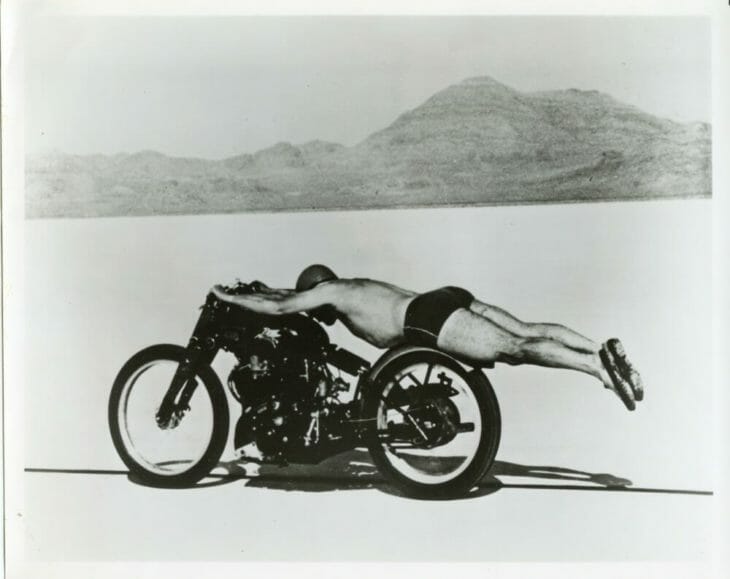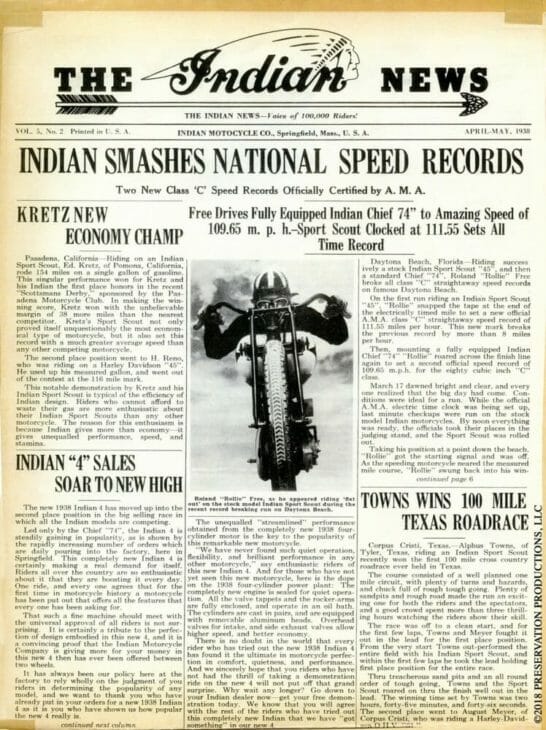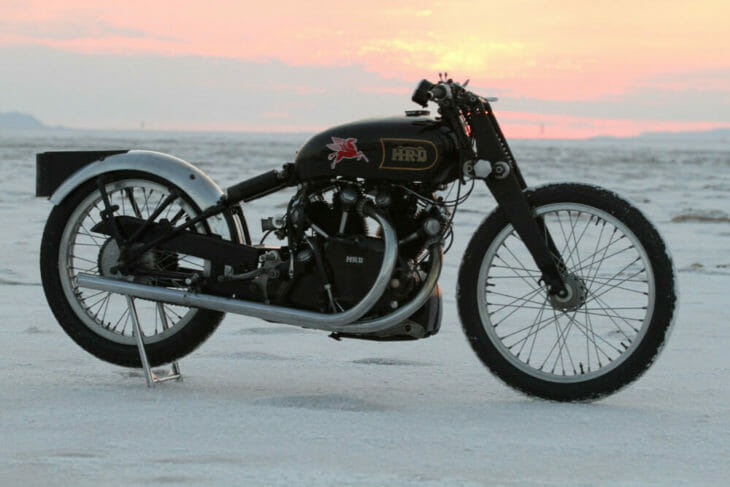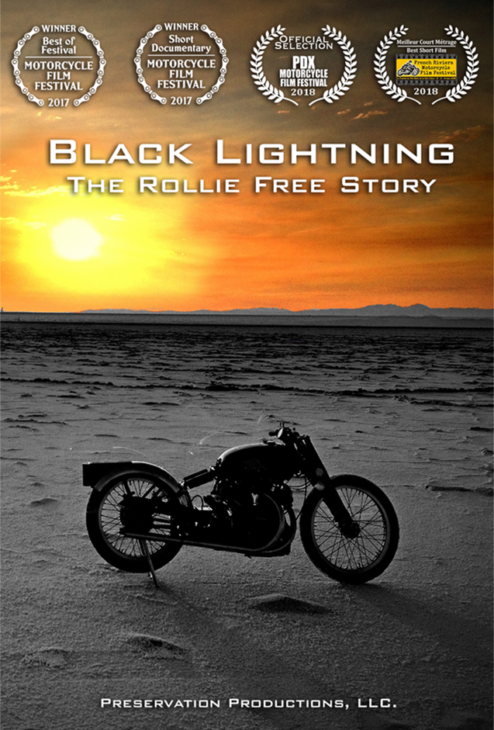Larry Lawrence | February 26, 2019
Archives: Bathing Trunks and Black Lightning
You know the photo – the rider stretched out on a speeding motorcycle on the salt in full Superman pose, wearing nothing but swim shorts, a pudding bowl helmet and tennis shoes. It’s undoubtedly one of the most famous photographs in the history motorcycling. The man in the photo was Rollie Free and he was on his way to setting a speed record on the Bonneville Salt Flats in 1948. The documentary Black Lightning – The Rollie Free Story gives us the backstory behind the iconic photograph and it’s top-notch storytelling.
Archives: Bathing Trunks and Black Lightning
 Stripped down to his swim trunks and riding in a Superman pose helped Rollie Free set a American speed record on a Vincent at Bonneville in 1948.
Stripped down to his swim trunks and riding in a Superman pose helped Rollie Free set a American speed record on a Vincent at Bonneville in 1948.
This documentary follows the life of Rollie Free from his early year, through his racing career in the 1920’s and 30’s, owning an Indian dealership, his military service, and his post-war life. At the core of the story is an unusual union of two very different men. One, from a world of privilege and the other from blue-collar middle-America. Their bond was their fierce determination to set an historic motorcycle speed record and to beat the Harley Davidson Motor Company.
Directed by Zach Siglow, the film tells the story of Rollie Free, John Edgar, a special Vincent dubbed “Black Lightning” and the team’s 1948 assault on the AMA Class A speed record at the Bonneville Salt Flats.
It’s amazing how much of a story the film tells in it’s relatively short 35-minute running time.
Wealthy sportsman John Edgar, who’d been a hydroplane racer in his younger years, wanted to own the fastest motorcycle in America. He’d met Vincent Motorcycle Company owner Phil Vincent and discussed the possibility of having Vincent prepare a special Vincent HRD that would be set up for speed trials. Vincent agreed and the factory built a special Vincent. Company engineers set the Edgar’s machine up to run on alcohol, included high lift cams, fitted special Amal carburetors and racing tires on Avon alloy rims. After the bike was completed, a factory rider tested the machine at a British airstrip and was able to reach 143 mph before running out of tarmac. That speed alone would be good enough to break the existing record.
The bike Edgar had ordered from Vincent was clearly capable of the record, now all he needed was a rider.
Roland “Rollie” Free had been a racer clear back to the board track days. His first success was on Harley-Davidson motorcycles and after winning some regional races, a sponsor offered to put up the money for Free to buy a factory Harley racer. Harley agreed to sell Free a factory rig, but according to Free, when he showed up to Milwaukee to pick up the bike, they tried to sell him a standard racer, not the factory special he’s been promised.
Angered by the way he felt he’d been treated in Milwaukee, Free said he made it his life’s mission to beat Harley-Davidson whenever and wherever he could.

By sheer chance Edgar met Free at a gas station/repair shop Free owned in Los Angeles. The two struck up a conversation about their mutual love of fast motors and when Edgar found out Free had been a record-setting motorcycle racer, he knew he’d found just the guy who could help him make his goal of owning the fastest motorcycle in the country possible.
The movie goes into the details of the successful attempt to become the first AMA Class A motorcycle to break the 150-mile-per-hour barrier. It is told by way commentary from motorcycle racing experts like well-known motorcycle author Jerry Hatfield, who wrote the book “Flat Out! The Rollie Free Story”, motorsports historian and television personality Alain de Cadenet, fellow motorcycle land speed racer Marty Dickerson, William Edgar, son of the bike’s original owner, vintage bike expert Glenn Bator and Chip Conner, who is both the owner of the famous “Bathing Suit Bike” and was Executive Producer of the documentary.
The film makes wonderful use of of archival footage and photos, including old Super 8 film taken at Bonneville during Free’s record-break runs. It even includes segments of audio interviews done with Free himself just a few years before his passing in 1984. You can tell from some of the terminology used by Free, that he was a man of a different time in American history.
While Edgar was eager to own the fastest motorcycle in America, the film reveals that in Free’s mind if they could earn the record, it would be poetic payback to Harley-Davidson all those years after they snubbed him. In 1948, Harley factory racer Joe Petrali held the American record of 136.183 mph set on a modified Harley-Davidson Model E on the beach at Daytona in 1937.

Unfolding in the film is the reason Free ultimately stripped down to his swim trunks to make the record run. That too is wonderfully illustrated.
A photo of Free’s record-setting run was featured in the October 4, 1948 issue of Life Magazine, but not the swimsuit clad photo that became so famous. Exactly who took that famous photo has been lost to time.
James Gabler, who works for Preservation Productions, the company that produced the documentary, jokes that Free was such a fan of less friction, “That if Nair had been around then he would have dipped his body in it.”
Gabler said in all the documentary was over six years in the making.

The interviews, photos and archival film footage, put the meat of the bones of Free’s personality. He was a man of great determination and that especially comes out in the film when it reveals that the speed record had already been broken by the time Free stripped down to his swim shorts.
“But he was the kind of guy that figure that the record of 148 just wasn’t good enough,” Gabler said. “He knew breaking 150 was a magical mark that people would remember.”
If you’re looking for a great documentary to watch, especially when your motorcycle buddies are over, you won’t go wrong with Black Lightning – The Rollie Free Story.
You can rent the movie on Vimeo.
For additional information visit: https://www.bathingsuitbike.com/